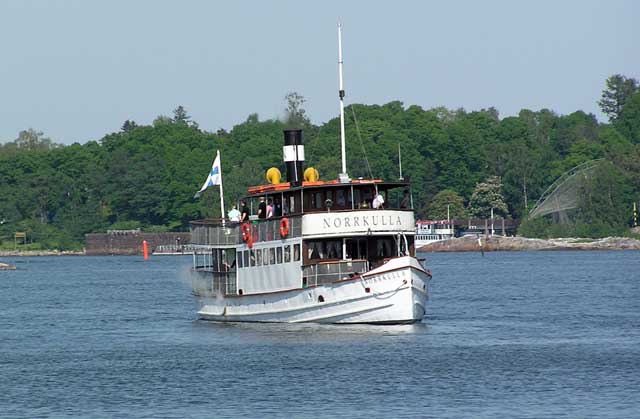In Nauvo, located in the Turku archipelago, it was decided in 1911 to establish the Steamship company Ångbåtsaktiebolaget As to improve the municipality’s weak transport connections and to order a ship from it, which would also become “Nagu” (Nauvo’s Swedish name). The idea of acquiring a ship was not new in the locality, but now real action was taken and the ship was ordered from the Lehtoniemi workshop in Joroinen. A special feature of the order was that the ship’s hold had to be suitable for transporting live fish. The ship was due to be completed in September, and it worked quite well: As left via the Saimaa canal towards Turku at the end of October 1911 and arrived in Turku on November 10.
The shipping company was satisfied with its new ship. Initially, the 20.4-meter ship traveled ten knots and was allowed to take 99 passengers. It was a single deck, and at the deck level there was a Tobacco salon at the Stern, and below it at the Stern of the Hull, a salon-restaurant. The decor was more practical than boastful. On the bow side of the salon were the kitchen, toilet and ticket office. On either side of the engine and boiler room insulated by sheet metal walls, the sides of the ship were surrounded by longitudinal benches, with the Cabins of a restaurateur and a non-commissioned Officer facing the bow. On the bow side of these was a cargo hold, and right on the bow Spike still Skanssi for four crew members. In addition to the chief, the staff included five men.
The ship’s route became Turku – Hanka – Seili – Nauvo Kirkonkylä – Rosala – Ytterholma – Kirjala, although the route varied somewhat on different days of the week. In 1913, while on the way to Nauvoo, it tried the new Norrsundet route in Pargas. Although the number of passengers was reasonable, the Indebted company had to sell the ship by forced auction in 1915. The Buyer was Vulcan’s workshop in Turku, but the Russian military authorities forced the ship to be used almost immediately. The ship, painted black, was named “Nyrok” (Sotka), and began transporting mainly military personnel to the Fortifications of the archipelago. After the war, the ship returned to Vulcan, which sold it in 1918 in Helsinki to a company called Norrkulla Ab. The deal included refurbishing the vessel at Vulcan’s workshop and extending it by 3.8 meters. The ship also received a bridge from which a wheelhouse was placed.
The ship, named Norrkulla, arrived in Helsinki in the summer of 1919. After the extension, the ship was allowed to take 130 passengers. It began to pass from Helsinki via the Strait between Hevossalmi and Jollas and Villing to the island of Lilla Bastö and further via Kamsholmen and Röysö to the Pier of the Norrkulla boarding house, from where it continued via the Sandholmen and Kaptensudden piers to the overnight place Sipoon Box. From there we left early in the morning back to Helsinki. In 1921, a company was established for the ship, Trafikaktiebolag Sibbo Skärgård. Completion of the new Porvoonti in 1935 started bus traffic and improved transport connections to Sipoo, which eventually drove the shipping company into Bankruptcy in 1938. The Buyer was an experienced ship broker Viktor Lenkkeri from Koivisto, who resold it to Sääming Saaristo Höyrylaiva Oy in Savonlinna .
The new owner renovated the boat again at the Savonlinna workshop. The Hull and Cabins of the ship were refurbished, a Generator driven by an auxiliary steam engine was installed, and the boiler was refurbished and converted to log heating. The number of passengers had to be reduced to 87. The ship, named “Archipelago”, sailed in the Savonlinna archipelago, stopping at numerous piers between Pietolansaari and Savonlinna. Pietolansaari left at five in the morning and returned to seven countries in the evening. The one-way trip took about four hours. In addition to other passengers, the Archipelago transported schoolchildren to Laukansaari Primary School and apprentices to Savonlinna. In addition, cargo was transported: milk and animals to the city, Merchandise and supplies to the islands. In the autumn, the joint threshing machine of Sääminkilä was driven from one island to another. Mail transport was also part of the ship’s duties. In 1952, the company bought Ahlström’s old tar steam Mira I, whose machine and boiler were moved to the Archipelago at the Lypsyniemi workshop.
After the state decided to take care of the Sääming archipelago traffic in 1975, the “Archipelago” was put up for sale. It was bought by Kosti Turunen from Savonlinna and Erkki Riimala from Helsinki, who founded a company called Kyrönsalmen Höyrywenhe Osakeyhtiö. The ship was named “Figaro” and began to do more than an hour of landscape cruises. Later, changes were made to the ship again. The old cabin structure from the time of the Naval Ship was dismantled inside the side panels and the space was turned into a Cohesive Café, which was also slightly extended towards the bow. Turunen sold his company in the autumn o
f 2000 to a new owner who announced that he would diesel Figaro. In the end, however, this is never materialized.
In the summer of 2004, Figaro was the last in Saimaa. New owner, Lc. Lesa Oy, moved the ship to Helsinki in 2005, and gave it the name “HöyryJuho”. The following winter, the beginning will be renovated again
echnical information
- Name: Norrkulla
- Type: Passenger ship
- Home port: Helsinki
- Completed: 1911
- Builder: Lehtoniemi & Taipale Fabriker, Varkaus
- Former names: Nagu (1911-15), Nyrok (1915-18), Norrkulla (1918-38), Saaristo (1938-75), Figaro (1975-2004), HöyryJuho (2004-2006)
- Lenght: 25.19
- Beam: 4.87
- Draught: 1.32
- Speed (knots): 10
- Owner: Helsingin Höyrylaivaosakeyhtiö
- Former owners: Ångbåtsaktiebolag Nagu (1911-15), Ab Vulcan, Turku (1915-18), Norrkulla Aktiebolag, Helsinki (1918-21), Trafikaktiebolag Sibbo Skärgård (1921-38), Säämingin Saariston Höyrylaiva Osakeyhtiö (1938-75), Kyrönsalmen Höyrywenhe Oy, Savonlinna (1975-2000), Pentti Metsberg (2000-2004), Lc. Lesa Oy, Helsinki (2004-06)
- A nice to know fact about the ship:
- Engine type: Compound
- Engine built: 1917
- Engine manufacturer:
- Engine power (ihp):
- A nice to know fact about the engine:
- Boiler type: Scotch marine boiler
- Boiler built: 1917
- Boiler manufacturer: A. Ahlström Oy, Varkaus
- Fuel: Oil
- Furnaces (number): 1
- Operating pressure (bar): 8
- Heating surface: ?
- A nice to know fact about the boiler:




